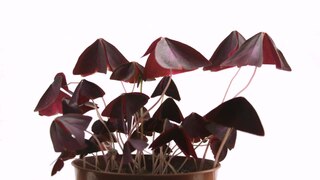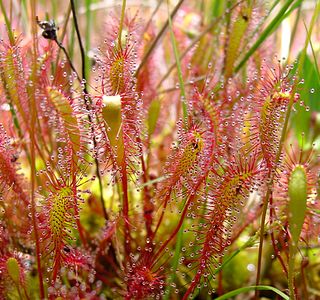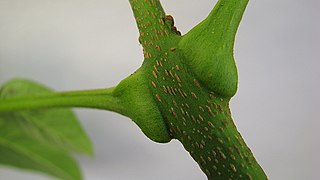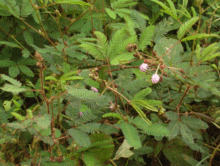
Drosera, which is commonly known as the sundews, is one of the largest genera of carnivorous plants, with at least 194 species. These members of the family Droseraceae lure, capture, and digest insects using stalked mucilaginous glands covering their leaf surfaces. The insects are used to supplement the poor mineral nutrition of the soil in which the plants grow. Various species, which vary greatly in size and form, are native to every continent except Antarctica.

Droseraceae is a family of carnivorous flowering plants, also known as the sundew family. It consists of approximately 180 species in three extant genera. Representatives of the Droseraceae are found on all continents except Antarctica.

The Venus flytrap is a carnivorous plant native to the temperate and subtropical wetlands of North Carolina and South Carolina, on the East Coast of the United States. Although various modern hybrids have been created in cultivation, D. muscipula is the only species of the monotypic genus Dionaea. It is closely related to the waterwheel plant and the cosmopolitan sundews (Drosera), all of which belong to the family Droseraceae. Dionaea catches its prey—chiefly insects and arachnids—with a "jaw"-like clamping structure, which is formed by the terminal portion of each of the plant's leaves; when an insect makes contact with the open leaves, vibrations from the prey's movements ultimately trigger the "jaws" to shut via tiny hairs on their inner surfaces. Additionally, when an insect or spider touches one of these hairs, the trap prepares to close, only fully enclosing the prey if a second hair is contacted within (approximately) twenty seconds of the first contact. Triggers may occur as quickly as 1⁄10 of a second from initial contact.

In plant biology, thigmotropism is a directional growth movement which occurs as a mechanosensory response to a touch stimulus. Thigmotropism is typically found in twining plants and tendrils, however plant biologists have also found thigmotropic responses in flowering plants and fungi. This behavior occurs due to unilateral growth inhibition. That is, the growth rate on the side of the stem which is being touched is slower than on the side opposite the touch. The resultant growth pattern is to attach and sometimes curl around the object which is touching the plant. However, flowering plants have also been observed to move or grow their sex organs toward a pollinator that lands on the flower, as in Portulaca grandiflora.

Rapid plant movement encompasses movement in plant structures occurring over a very short period, usually under one second. For example, the Venus flytrap closes its trap in about 100 milliseconds. The traps of Utricularia are much faster, closing in about 0.5 milliseconds. The dogwood bunchberry's flower opens its petals and fires pollen in less than 0.5 milliseconds. The record is currently held by the white mulberry tree, with flower movement taking 25 microseconds, as pollen is catapulted from the stamens at velocities in excess of half the speed of sound—near the theoretical physical limits for movements in plants.

Roridula is a genus of evergreen, insect-trapping shrubs, with two species, of about 1⅓–2 m. It is the only genus in the family Roridulaceae. It has thin, woody, shyly branching, upright, initially brown, later grey stems, with lance- to awl-shaped leaves crowded at their tips. The star-symmetrical flowers consist from the outside in of five, green or reddish, free sepals, alternating with five white, pink or purple, free petals. Further to the middle and opposite the sepals are five stamens with the anthers initially kinked down. These suddenly flip up if the nectar-containing swelling at its base is being touched. The center of the flower is occupied by a superior ovary. The leaves and sepals carry many sticky tentacles of different sizes, that trap insects. Roridula does not break down the insect proteins, but bugs of the genus Pameridea prey on the trapped insects. These later deposit their feces on the leaves, which take up nutrients from the droppings. The species can be found in the Western Cape province of South Africa. They are commonly known as dewstick or fly bush in English and vlieëbos or vlieëbossie in Afrikaans.

Mimosa pudica is a creeping annual or perennial flowering plant of the pea/legume family Fabaceae. It is often grown for its curiosity value: the sensitive compound leaves fold inward and droop when touched or shaken and re-open a few minutes later. It is well known for its rapid plant movement. Like a number of other plant species, it undergoes changes in leaf orientation termed "sleep" or nyctinastic movement. The foliage closes during darkness and reopens in light. This was first studied by French scientist Jean-Jacques d'Ortous. In the UK it has gained the Royal Horticultural Society's Award of Garden Merit.

Averrhoa carambola is a species of tree in the family Oxalidaceae native to tropical Southeast Asia; it has a number of common names, including carambola, star fruit and five-corner. It is a small tree or shrub that grows 5 to 12 m tall, with rose to red-purple flowers. The flowers are small and bell-shaped, with five petals that have whitish edges. The flowers are often produced year round under tropical conditions. The tree is cultivated in tropical and semitropical regions for its edible fruits.
Thermotropism or thermotropic movement is the movement of an organism or a part of an organism in response to heat or changes from the environment's temperature. A common example is the curling of Rhododendron leaves in response to cold temperatures. Mimosa pudica also show thermotropism by the collapsing of leaf petioles leading to the folding of leaflets, when temperature drops.

Drosera regia, commonly known as the king sundew, is a carnivorous plant in the sundew genus Drosera that is endemic to a single valley in South Africa. The genus name Drosera comes from the Greek word droseros, meaning "dew-covered". The specific epithet regia is derived from the Latin for "royal", a reference to the "striking appearance" of the species. Individual leaves can reach 70 cm (28 in) in length. It has many unusual relict characteristics not found in most other Drosera species, including woody rhizomes, operculate pollen, and the lack of circinate vernation in scape growth. All of these factors, combined with molecular data from phylogenetic analysis, contribute to the evidence that D. regia possesses some of the most ancient characteristics within the genus. Some of these are shared with the related Venus flytrap (Dionaea muscipula), which suggests a close evolutionary relationship.

In biology, nastic movements are non-directional responses to stimuli that occur more rapidly than tropisms and are usually associated with plants. The movement can be due to changes in turgor. Decrease in turgor pressure causes shrinkage, while increase in turgor pressure brings about swelling. Nastic movements differ from tropic movements in that the direction of tropic responses depends on the direction of the stimulus, whereas the direction of nastic movements is independent of the stimulus's position. The tropic movement is growth movement but nastic movement may or may not be growth movement. The rate or frequency of these responses increases as intensity of the stimulus increases. An example of such a response is the opening and closing of flowers, movement of euglena, chlamydomonas towards the source of light. They are named with the suffix "-nasty" and have prefixes that depend on the stimuli:

Aldrovanda is a genus of carnivorous plants encompassing one extant species and numerous extinct taxa. The genus is named in honor of the Italian naturalist Ulisse Aldrovandi, the founder of the Botanical Garden of Bologna, Orto Botanico dell'Università di Bologna. Aldrovanda vesiculosa has been reported from scattered locations in Europe, Asia, Africa, and Australia.

Drosera anglica, commonly known as the English sundew or great sundew, is a carnivorous flowering plant species belonging to the sundew family Droseraceae. It is a temperate species with a circumboreal range, although it does occur as far south as Japan, southern Europe, and the island of Kauai in Hawaii, where it grows as a tropical sundew. It is thought to originate from an amphidiploid hybrid of D. rotundifolia and D. linearis, meaning that a sterile hybrid between these two species doubled its chromosomes to produce fertile progeny which stabilized into the current D. anglica.

A pulvinus is a joint-like thickening at the base of a plant leaf or leaflet that facilitates growth-independent movement. Pulvini are common, for example, in members of the bean family Fabaceae (Leguminosae) and the prayer plant family Marantaceae.

Carnivorous plants are plants that derive some or most of their nutrients from trapping and consuming animals or protozoans, typically insects and other arthropods, and occasionally small mammals and birds. They still generate all of their energy from photosynthesis. They have adapted to grow in waterlogged sunny places where the soil is thin or poor in nutrients, especially nitrogen, such as acidic bogs. They can be found on all continents except Antarctica, as well as many Pacific islands. In 1875, Charles Darwin published Insectivorous Plants, the first treatise to recognize the significance of carnivory in plants, describing years of painstaking research.

Drosera glanduligera, commonly known as the pimpernel sundew or scarlet sundew, is a species of carnivorous plant endemic to southern Australia. It is an ephemeral annual plant that grows in the winter and flowers from August to November.

In botany, tentacles are glandular hairs on the leaves of some species of insectivorous plants such as Drosera (sundews). Tentacles are different from organs such as the tendrils of climbing plants.

Steel trap is an informal term in the study of comparative plant physiology of the carnivorous plants. "Steel trap", more particularly "active steel trap", refers to prey capture devices such as occur in some members of the family Droseraceae, and in particular in the genera Dionaea and Aldrovanda ("waterwheel"). The term apparently originated with the author Francis Ernest Lloyd in 1942, in which he adopted the overly general term "steel trap" rather than say, "gin trap" or a more adjectival form, for devices such as the lobed trap leaves of Dionaea.
Paraheliotropism refers to the phenomenon in which plants orient their leaves parallel to incoming rays of light, usually as a means of minimizing excess light absorption. Excess light absorption can cause a variety of physiological problems for plants, including overheating, dehydration, loss of turgor, photoinhibition, photo-oxidation, and photorespiration, so paraheliotropism can be viewed as an advantageous behavior in high light environments. Not all plants exhibit this behavior, but it has developed in multiple lineages.
A mechanoreceptor is a sensory organ or cell that responds to mechanical stimulation such as touch, pressure, vibration, and sound from both the internal and external environment. Mechanoreceptors are well-documented in animals and are integrated into the nervous system as sensory neurons. While plants do not have nerves or a nervous system like animals, they also contain mechanoreceptors that perform a similar function. Mechanoreceptors detect mechanical stimulus originating from within the plant (intrinsic) and from the surrounding environment (extrinsic). The ability to sense vibrations, touch, or other disturbance is an adaptive response to herbivory and attack so that the plant can appropriately defend itself against harm. Mechanoreceptors can be organized into three levels: molecular, cellular, and organ-level.
















